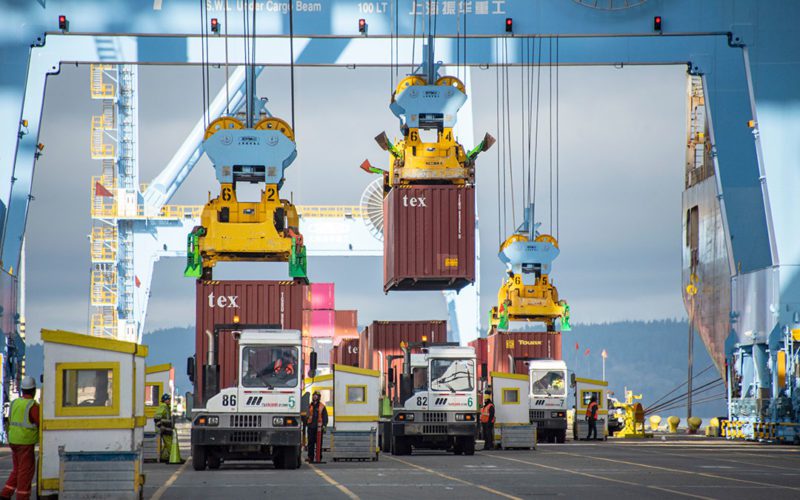The $1.2 trillion infrastructure bill recently passed by Congress will pump billions of dollars into the American system of roads, bridges and tunnels. Equally important is the money it makes available for the nation’s maritime industry.
The vast spending package allocates some $17 billion in maritime spending, along with additional maritime funding through separate programs. Money will be available for port infrastructure, improvements to navigable waterways, emissions reductions programs and marine highway projects, among other needs.
“We’re looking at this as a generational opportunity for our members,” said Craig Montesano, vice president for legislative affairs for the American Waterways Operators.
“But on the port side, they have also set aside $2.5 billion for port development in the form of harbor craft, decarbonized power trains, retrofits, infrastructure development in terminals and bunkering facilities, and investment in our ports to make them more efficient and make sure goods and cargoes are flowing through them.”
Other maritime organizations also celebrated passage of the plan, which boosts federal infrastructure spending to levels not seen in many years. Noel Hacegaba, chairman of the Intermodal Association of North America’s board of directors, and deputy executive director of the Port of Long Beach, called the package a “once-in-a-generation opportunity.”
Stephanie Casella, spokeswoman for the American Association of Port Authorities, a trade association based in Washington, also praised the package but would have liked it to go even further.
“Our general answer is that we are grateful but not contented because it has been negotiated down from where it was,” she said. “It’s going to help specifically with programs with the Army Corps and their coastal navigation program, which will dredge and maintain federal channels, and with sustainability initiatives and infrastructure surrounding sustainability.”
The plan calls for a standardization of data among shipping lines, terminal operators, railroads, truckers and cargo owners to move goods more efficiently through the supply chain, Casella said. “So, it covers a lot of ground.”
Passenger vessels also will see new funding under the proposal. The law creates a new $1 billion program for “essential ferry service” connecting rural areas. The plan should benefit Alaska’s Marine Highway System, which has faced budget cuts and other challenges. For the first time, funds can be used for operating expenses, not just capital costs.
Also included is $337 million for new ferries and ferry terminal facilities and $250 million toward a pilot project for electric and other low-carbon emission ferries. The bill allows Alaska to apply federal highway funds to its Marine Highway System. The legislation creates a $50 million grant program for ferry systems that build new low-emissions vessels or repower existing ships.
Much of the $17 billion in maritime funding will pass through the U.S. Army Corps of Engineers. And of that sum, about $11.6 billion is set aside for construction projects.
Roughly $1.5 billion would go toward harbors and navigation channels, while another $2.5 billion will go toward inland waterways. Flood management on the coast and inland waterways will receive $5 million. Another $550 million will support construction and maintenance of the Mississippi River and its tributaries.
The Army Corps will have an important role in determining which projects get funded. It has 90 days after enactment to submit to Congress how it intends to allocate the money. It must apprise Congress at regular intervals thereafter as to what projects are being funded.
“The funds will enable USACE to develop, manage, restore and protect water resources through the construction, operation and maintenance, and study of water-related infrastructure projects,” Gene Pawlik, spokesman for the Army Corps of Engineers, said in an email. “The act’s appropriations will also enable USACE to regulate development in waters of the United States.”
The Army Corps has stewardship responsibilities for approximately 25,000 miles of commercially navigable waterways. That total includes 12,000 miles of intracoastal and commercially navigable rivers, as well as 237 lock chambers at 192 sites on the inland waterways. The bill specifically allocates $25 million for waterways utilized by container-on-barge vessels.
Among inland waterways, locks and dams on the Ohio, Brazos, Mississippi and Monongahela rivers, and many others could be targeted for funding.
The USACE is also charged with improving and maintaining harbors facilitating the nation’s seaborne commerce. That includes the major deep-draft harbors and more than 800 smaller harbors such as Mobile, Jacksonville and other ports undertaking channel deepening and widening projects. Ports can potentially access some $16.7 billion available for rail improvement and flood mitigation projects.
The legislation also calls for the establishment of an Office of Multimodal Freight Infrastructure and Policy to be included in the Department of Transportation. The office is envisioned to provide oversight of issues arising from the many links of intermodal transport in ports and on highways.
Several different departments and government agencies will oversee spending of the broader infrastructure money, including the Departments of Transportation and Energy. It is unclear, at this stage, when maritime-related projects will begin.
The best guess is that roughly $20 billion of the $566 billion in infrastructure-specific spending within the broader $1.2 trillion package will be spent by the end of fiscal year 2022, according to the Congressional Budget Office. About $125 billion, almost a quarter of the funding, will be spent by September 2024, the agency said.
Mike Roberts, president of the American Maritime Partnership, suggested economic activity caused by the bill could spur shipbuilding activity, providing an additional benefit to the maritime sector.
The plan, Roberts said, “invests in our nation’s maritime ports and inland waterways and supports American offshore wind development, which will provide greater opportunities to build new American vessels and employ mariners.”

